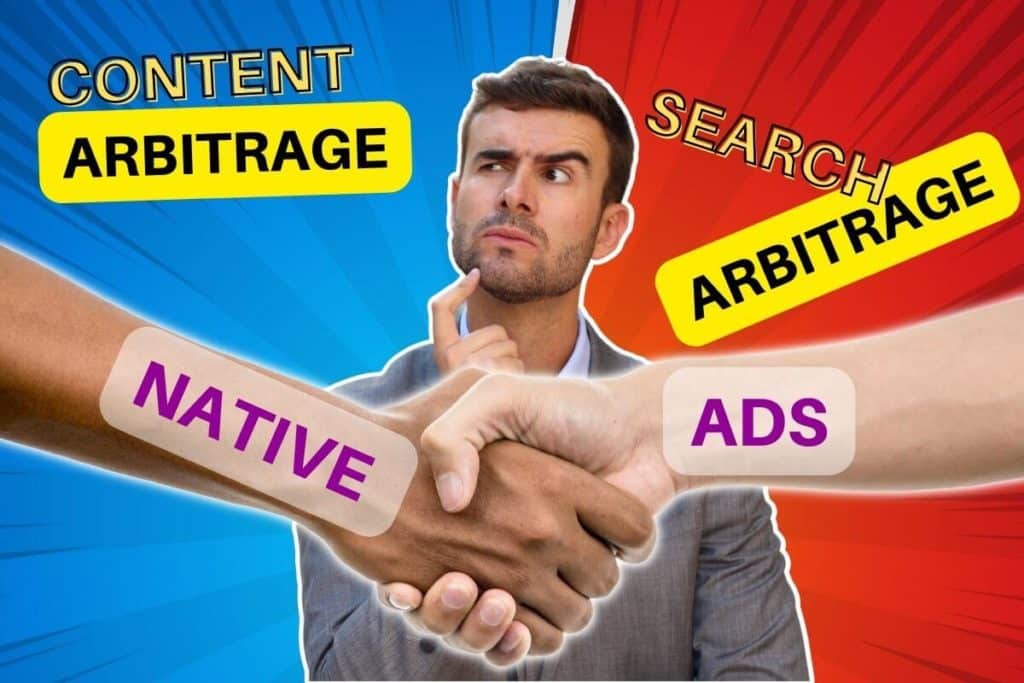Today, we will step into digital entrepreneurship and unlock the potential of cutting-edge content arbitrage techniques.
Imagine you’re in a bustling digital marketplace where everyone’s sharing ideas, stories, and information. People are looking for interesting stuff, and creators like you are there to provide it.
But wait, there’s a secret game happening behind the scenes – it’s called Content Arbitrage. Think of it like a clever strategy game where you find the best Content, share it in the right places, and make a profit.
It’s all about knowing what people want and giving it to them. Today, we’re going to uncover this hidden world together.
We’ll talk about how it’s evolved and how you can use it. So, get ready to explore the exciting world of content arbitration with me!
Let’s dive in and discover what’s in store for 2024.
What is Content Arbitrage?
Content arbitrage is like buying something cheap and selling it for more, but with Content, it’s about knowing that the same information can be worth more in different places.
It happens when we take existing Content and make it better to sell it for a higher price. It’s like finding good stuff at a thrift shop and making it valuable again.
Finding Opportunities:
Content arbitrage works best when some people have useful information that others don’t because it’s hard to get.
Here are some ways to find and use content arbitrage:
Collect Information: Sometimes, good ideas are spread out in different places. By bringing them together, we can make something that everyone likes.
Use Content Again: Take something already made, like a blog post, and turn it into something else, like a picture or a video. This makes it attractive for more people.
Copy Good Ideas: Try it yourself if something worked well somewhere else. Add your own thoughts to make it new.
Think About Your Business: Make sure whatever you do helps your business in some way. That way, it’s useful and reaches more people.
Content Arbitrage in Action:
Imagine finding a good blog post that nobody reads. By making it into a video or a picture, suddenly, more people care about it.
The important thing is to make good things that last and help people. Content arbitrage is more than just buying and selling; it’s about making things valuable again for everyone.
How Does Content Arbitrage Work?

Content Arbitrage is like finding hidden treasures on the internet!
Let’s break it down:
Step 1: Hunt for Hidden Gems
Imagine searching for cool stuff online that not many people have seen yet. It could be articles, videos, or even research papers tucked away in the web’s obscure corners.
Step 2: Make Them Shine
Once you find these hidden gems, it’s time to polish them up! You can make them better by organizing the information neatly, turning them into easy-to-understand summaries or fun infographics, and even sharing your own thoughts to make them more interesting.
Step 3: Share with the Right People
Now, it’s all about getting these shiny treasures to the right audience. Consider who would love to see them – maybe folks in a specific hobby group or industry. Share them on social media, through emails, or on websites where people hang out.
Step 4: Make Some Money
Believe it or not, you can earn cash by sharing these treasures! You can put ads or links in them that earn you money when people click on them. You can also turn them into courses or e-books that people pay for, or even offer your expertise to others.
Step 5: Keep Hunting!
Content Arbitrage isn’t a one-time thing. Keep searching for more hidden treasures, making them shine, and sharing them with the world. And always be ready to learn and adapt as things change.
Is Content Arbitrage Legal?
Content Arbitrage is when you use existing stuff in a new way to make it worthwhile. But whether it’s okay depends on where you are and what you’re doing.
Here are some things to think about:
Fair Use: Some places have rules that let you use a little bit of someone else’s stuff without asking, like for reviews or teaching.
Copyright Laws: If you use someone else’s stuff without permission, you could get in trouble. Don’t copy too much or do it without asking.
Give Credit and Change Things: If you say where you got stuff from and change it a lot, it’s more likely to be okay.
Making Money or Not: If you’re trying to make money from using other people’s stuff, it’s harder to get away with it.
Public Domain and Special Permissions: Some stuff you can use for free, but others have rules you need to follow. Always check what’s allowed.
Different Places, Different Rules: What’s okay in one place might not be in another. It’s important to know the rules where you are.
Disclaimer: Remember, I’m not a lawyer. If you’re worried about using other people’s stuff, talk to someone who knows the law.
What are some examples of content arbitrage?
Let me show you a few cool ways people share stuff online:
Weekly Emails: Picture this – you find lots of interesting articles and blogs about something you love, like saving the environment or being more productive. You put them together into a friendly email every week, adding your own thoughts. People subscribe to get these emails because they’re full of great info.
YouTube Mixes: Instead of making your own videos, you search YouTube for funny, helpful, or popular clips. Then, you organize them into playlists based on different themes. Your channel becomes a fun place for people to watch stuff, and you can even make money from ads.
eBook Collections: Have you ever read excellent blog posts or essays on a topic you’re into? You gather them up and turn them into an eBook. It’s like having a library of useful info all in one place.
Social Media Stories: You find interesting tweets, Instagram captions, or LinkedIn posts. Then, you turn them into longer articles or podcast episodes. It’s a way to share cool ideas with more people in different ways.
Turning Quora Answers into Articles: Quora is full of smart answers from experts. With their permission, you take those answers and turn them into detailed articles. It helps the experts get noticed and gives readers helpful info.
Podcast Chats from Blogs: Imagine finding great blog posts with lots of smart ideas. You talk to the writers or other experts and turn their words into fun podcast episodes. It’s like having a chat with friends about cool stuff you’ve read.
Identifying Profitable Content Niches
Finding profitable content niches in 2024 is all about using tools and keeping an eye on what’s hot.
Using tools like Google Analytics or BuzzSumo, we can learn a lot about what people are searching for and what our competitors are up to.
It’s like peeking into a crystal ball to see what’s coming next! And by paying attention to trends, we can spot opportunities before they become old news.
So, by mixing these insights with our gut feelings, we can find those sweet spots where our Content can really shine and make some serious waves in 2024.
AI Content: Short-term Gain, Not Long-term Strategy
When it comes to making Content, using AI might seem like a quick fix. But let’s be real: AI-made stuff can be pretty dull.
It lacks that human touch that makes Content really connect with people. And if you’re trying to build a brand, you need that connection.
People can tell when something’s not genuine, and they won’t stick around for junky Content.
Plus, relying too much on AI doesn’t give you any real advantage in the long run. It’s like building a house on shaky ground—it won’t hold up over time.
So, in 2024 and beyond, focus on creating accurate, relatable Content that keeps people coming back for more.
Creating High-Quality Content Assets
Making awesome Content means putting in effort to create stuff people really love.
It’s all about finding out what folks are into, what they care about, and then making stories and videos that speak to them.
Using pictures, videos, and fun stuff like that can make it even better because it keeps people interested and makes the Content more enjoyable.
So, if you want to be a content pro, focus on making cool stuff and adding some fun visuals to keep everyone engaged.
Platforms and Channels for Content Distribution
Getting your Content out there means using all sorts of places!
Think social media like Facebook, Instagram, Twitter, and LinkedIn, where many people hang out. But don’t forget about smaller groups and forums where folks with special interests gather – they can be super into what you’re sharing.
And keep an eye out for new places popping up, like cool virtual reality spots and clever AI tools that recommend stuff people might like.
It’s all about finding where your audience is and making friends there!
How to Find Arbitrage Opportunities
To find great content deals, start by gathering bits of info from all over the place.
It could be articles, videos, or stuff from social media. Then, take all that info and turn it into something new, like a blog post or a fun infographic.
Make sure it’s in a style your audience likes. And if there’s some fancy talk involved, don’t worry! Just explain it in a way that everyone can understand.
That way, your audience will really connect with what you’re sharing. That’s how you make the most out of content deals in 2024!
Optimizing Content for Maximum Reach
Getting your Content seen by lots of people means using smart tricks that make it easier to find and share.
One way is by using SEO, which basically means making sure search engines like Google can easily find your stuff. This involves using the right words, tags, and links.
But that’s not all. You’ve also got to think about making your Content super shareable. That means creating stuff that’s so interesting or funny that people can’t help but pass it on to their friends.
It’s like planting a seed and watching it grow into a big, beautiful tree that everyone wants to see.
By combining these strategies, you can make sure your Content reaches as many folks as possible and leaves a lasting impression.
Content Arbitrage Techniques for Monetization
One way is by showing ads in your stuff to make money.
You can also team up with companies through affiliate marketing, where you get paid when people buy stuff through your links.
Another cool way is by doing sponsored Content. This means brands pay you to talk about their stuff in your Content.
So, by using these techniques, you can make some serious dough while doing what you love.
Building Sustainable Content Arbitrage Systems
When it comes to creating sustainable content strategies, it’s all about finding the sweet spot between making things easier through automation and making sure the Content we put out is top-notch.
Automation tools help us do things faster and reach more people, which is great. But at the same time, we’ve got to remember the importance of quality.
It’s like cooking a meal – we want to serve a lot of people, but we also want every dish to be delicious.
So, while we’re using tools to get things done efficiently, we’re also making sure each piece of Content is carefully crafted and worth sharing.
That balance is what keeps our content game strong and our audience happy.
Staying Ahead: Trends and Innovations in Content Arbitrage
Keeping up with content arbitrage means staying on top of new ideas and cool tricks.
One neat thing people are doing is using fancy math, called predictive analytics, to pick out the best Content before anyone else does.
It’s like having a crystal ball for what people will like!
Also, they’re adding cool stuff like virtual reality (VR) and augmented reality (AR) to make Content super fun and immersive.
Imagine feeling like you’re right there in the story! These new tricks help keep Content fresh and exciting, ensuring everyone stays entertained and happy online.
Ethical Considerations in Content Arbitrage
When it comes to sharing Content online, it’s super important to be honest and upfront about where it comes from.
Think of it like this: if you’re using someone else’s work, it’s like borrowing something from a friend – you need to ask first and give credit where it’s due.
This means being clear with your audience about where you got the Content and making sure you’re not copying stuff without permission.
It’s all about being respectful and fair to the people who created the Content in the first place.
Doing this builds trust and keeps things above board for everyone involved.
Future Outlook: The Evolution of Content Arbitrage
Things are getting exciting, and I am looking forward to the future of content arbitrage beyond 2025!
We can expect smarter strategies thanks to cool tech like AI, making it easier for creators to predict trends and create awesome Content.
Plus, there are new ways to share Content, like VR and AR, which could open up lots of opportunities. But we also have to be aware of rules and regulations.
Governments are starting to pay more attention to what’s happening online, so we might see some changes in how we can do things. It’s all about adapting and staying on top of things!
Analyzing Metrics and Performance
Identifying the right Key Performance Indicators (KPIs) is the first step towards measuring the effectiveness of your Content.
Metrics such as click-through rates, conversion rates, engagement metrics, and revenue generated per piece of Content provide valuable insights into audience behavior and content performance.
With these KPIs in place, employing iterative optimization strategies becomes crucial. This involves constantly refining and improving Content based on the gathered data, adjusting distribution channels, headlines, formats, and even content topics to maximize performance.
By iteratively optimizing Content based on metrics analysis, content arbitrage practitioners can stay ahead of the curve and ensure their strategies remain effective in an ever-evolving digital landscape.
Conclusion
In wrapping up, the content world in 2024 is bursting with cool tricks for creators and marketers.
We’ve covered a lot, from using platforms to recycling content cleverly. But the big takeaway? It’s all about being flexible and coming up with fresh ideas.
Keep your finger on the pulse of what’s new, and don’t be afraid to try new things.
As you journey through the world of content, remember to stay open to change and keep innovating. Your successive big win could be just around the corner!
I hope you liked the article and I fulfilled your search intent. Please comment below with your thoughts and share this post with others.
Also, remember to subscribe to our email newsletter to keep receiving the valuable content directly in your inbox.
Frequently Asked Questions
What is content arbitrage, and how does it differ from traditional content marketing?
Content arbitrage is the practice of acquiring content from one source and redistributing it for profit elsewhere, often without adding significant value. It differs from traditional content marketing, which focuses on creating original, valuable content to attract and engage audiences, ultimately driving desired actions such as brand awareness, lead generation, or sales.
How can small businesses benefit from content arbitrage techniques?
Small businesses can benefit from content arbitrage techniques by leveraging existing content from various sources to quickly populate their own platforms, such as websites or social media channels. This approach can save time and resources in content creation while still providing valuable information to their target audience. However, it's essential to ensure that the redistributed content adds genuine value and complies with copyright laws to avoid potential legal issues.
Are there any risks associated with content arbitrage, and how can they be mitigated?
Yes, there are risks associated with content arbitrage, including potential copyright infringement, diminished brand reputation due to low-quality or irrelevant content, and penalties from search engines for duplicate content. These risks can be mitigated by ensuring that redistributed content adds unique value, obtaining proper permissions for content use, properly attributing sources, and focusing on creating original content alongside curated material. Regularly monitoring performance and adjusting strategies can also help mitigate risks associated with content arbitrage.
What role does storytelling play in successful content arbitrage campaigns?
Storytelling plays a crucial role in successful content arbitrage campaigns by helping to engage audiences, create emotional connections, and differentiate content from competitors. A compelling narrative can make curated content more memorable and impactful, increasing its effectiveness in driving desired actions such as brand awareness or sales.
How can content creators stay updated with the latest trends and technologies in content arbitrage?
Content creators can stay updated with the latest trends and technologies in content arbitrage by regularly following industry blogs, attending relevant webinars and conferences, joining online communities and forums, subscribing to newsletters and publications, and networking with peers. Additionally, they can leverage social media platforms and specialized tools to monitor discussions and insights related to content arbitrage.
Is AdSense arbitrage legal?
AdSense arbitrage can be legal as long as it adheres to Google's AdSense policies and guidelines. However, it's essential to ensure that the content and traffic generation methods comply with all applicable laws and regulations, including those related to copyright, trademark, and deceptive advertising practices. Violating these guidelines can result in penalties or account suspension from Google AdSense.
How do I start AdSense arbitrage?
To start AdSense arbitrage, you need to follow these steps:
- Create a website or blog with valuable content that attracts visitors.
- Sign up for Google AdSense to display ads on your site.
- Research and identify niches with high advertising demand and low cost-per-click (CPC).
- Drive traffic to your website through various channels, such as SEO, social media, or paid advertising.
- Optimize your ad placements and targeting to maximize revenue.
- Monitor performance closely and adjust strategies as needed to increase profitability while ensuring compliance with AdSense policies.
What is an example of ad arbitrage?
An example of ad arbitrage is when a website owner purchases traffic at a low cost from platforms like social media or ad networks and directs that traffic to their website where they display ads, such as Google AdSense. If the revenue generated from the ads exceeds the cost of acquiring the traffic, the website owner profits from the price difference. This practice involves finding the right balance between ad revenue and traffic acquisition costs to ensure profitability.












